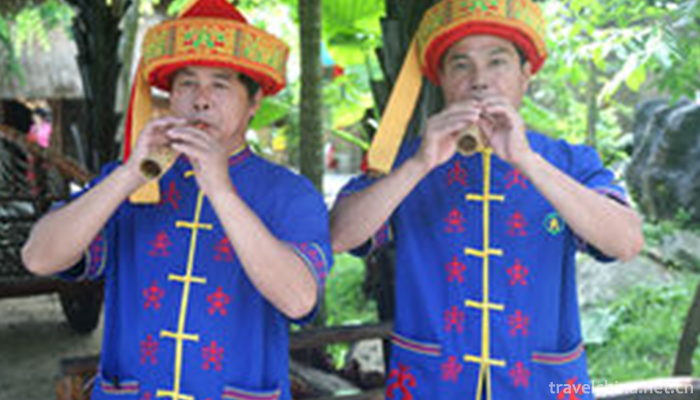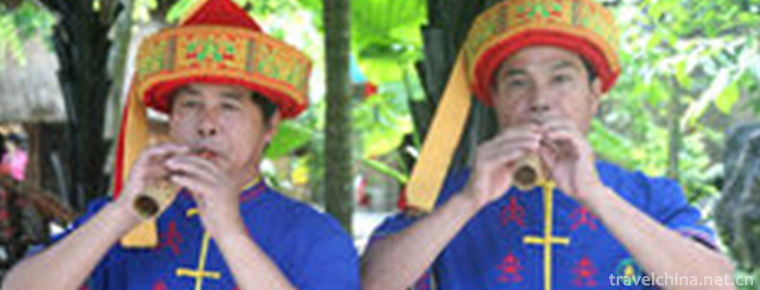Li Folk Songs
Li Folk Songs
Folk songs play an important role in daily life. Almost all men, women and children can sing. Especially on festive days, singing is an indispensable recreational activity. In the daily production work, they also sing impromptuly. The content of folk songs is mostly love songs, such as "Anti-Marriage Song" is a long narrative song. There are labor songs, wedding songs, grand ceremonies, ghost songs and so on. Li folk songs can be divided into traditional old folk songs sung in Li language and folk songs sung in Hainan dialect, which are influenced by Han culture. Li Ge has a set of beautiful tunes, similar to singing tunes, such as "Luoli Tune" in Qiongzhong and Baoting Counties, and "Shui Man Tune" in Qiongzhong County.
In 2008, Li folk songs were approved by the State Council to be included in the second batch of national intangible cultural heritage list.
historical origin
The Li people live in Tongshi Town, Baoting, Ledong, Dongfang, Qiongzhong, Baisha, Lingshui, Changjiang and Guanxian on Hainan Island. They are a branch of the ancient Baiyue people. The Li people have their own language. The Li language belongs to the Li branch of the Zhuang and Dong languages of the Sino-Tibetan language family. Because of long-term contact with the Han people, many Li people can speak Chinese at the same time. In the past, the Li people did not have their own written language and used Chinese characters. In 1957, they created the Latin-based Li language.
artistic characteristics
Characteristics of Li Folk Songs
Li folk songs are a gorgeous flower of art. People of Li nationality love to sing. Li folk songs can be divided into folk songs and folk songs. Folk ballads are sung in Li language and rhyme, mostly in traditional classical Li songs, usually with five syllables and one sentence, but there is no fixed number of sentences in each song. Generally, four sentences are used as one song in minors.
Li folk songs are mostly solo and duet. They are accompanied by Li's unique folk music. They are often combined with music and dance. They are composed of songs and songs. They have distinct national characteristics and strong ancient customs. They are rhythmic and easy to be praised by mouth. Li folk song is sung in Hainan dialect and Li rhyme. It is a new Li song derived from the development of Li society and the exchange and integration of other national cultures. Generally, there are seven sentences, one sentence and four sentences, which are called "four sentences songzi". The longer narrative poems are four sentences and one section. They are continued in many sections. In addition to solo and duet singing, there are Qi Zeng, rotation, chorus and accompaniment of musical instruments. Li's ballads are rich in imagination, appropriate in metaphor, rigorous in structure, far-reaching in artistic conception and lively in use of Fu, Bi and Xing. Love songs, which are exquisite treasures in Li folk songs, are in large numbers. The Li people sing ballads, mainly on festive days, such as building new houses, holding weddings, Festival theatres, visiting relatives and friends and other occasions, usually men and women sing in pairs, often to the dawn. Especially in the traditional festival of "March 3rd" every year, young men and women gather in the hillside, with songs as the medium, to exchange feelings, pour out love and find couples. Usually in the production of labor, but also because of interest to sing a song, direct expression of feelings. In some family celebrations, respected elders often impromptuly sing all-inclusive "classical" Li Songs, which are sung all night long.
During the period of revolutionary war, Li folk songs developed again. It replaces the backward and passive parts of the original songs with the revolutionary content and high-spirited style, and becomes a weapon to educate the people to fight against the enemy. For example, Five Rivers on Wuzhishan expresses the strong revolutionary belief of the Li people with firm and optimistic mood and joyful lyrics. After listening, it makes people feel energetic and ambitious. Li singers emerge in an endless stream and emerge in batches. The most famous singers are those who conform to their virtues.
Li nationality musical instruments
The instruments of Li nationality are mainly folk ones. These instruments can be solo or accompanied. Among them, "Wow" (that is, "bamboo flute") is made of bamboo tubes of different lengths, 2 feet, 1 foot and a half, and 6 inches and 7 inches. The end of the blow is corked, leaving only one fifth of the air vent. The pore is partially like a crescent moon. There are six small holes on the front of the tube. When playing, the left and right hands press three phoneme holes respectively. As the fingers open or close, they can play eight intervals, such as 1234567i. It's loud and loud.
"Dongxiao" is made of rattan and bamboo poles. It is 1 inch thick and 4 feet long. There is a blow hole at the edge of the pipe head. The opposite side of the pipe pole is 1.5 feet away from the pipe head. The front side of the pipe pole is 1.5 feet away from the pipe head. There are three sound holes downward. It can be divided into vertical blowing and bamboo tube blowing. For vertical blowing, the tube head is covered with dew-pocket leaves to control the size and strength of blowholes; for small bamboo tubes, the blowholes are inserted with a 4-5 inch long bamboo tube with the thickness of a pen tube and wrapped with dew-pocket leaves. When playing, the left thumb holds the opposite phoneme hole, the middle finger holds the front first phoneme hole, and the right index finger and the middle finger holds the second and third phoneme respectively. From these four phoneme holes, 7 intervals, such as 1234567, are blown out. The tone is broad, melodious and full of life sentiment.
Lizu ballads, with their rich lyrics and various melodies, are both graceful and passionate. They reflect the simple, optimistic, honest and forthright character of the people of the Li nationality.


-
1.Naturalization TempleSongdan Songzanlin Temple
Kardan Songzanlin Temple is the largest Tibetan Buddhist monastery in Yunnan Province
Time 2018-10-20 -
2.The Old Site of Command of 115 Division of Shandong Province Government and Eighth Route Army
The former site of Shandong provincial government and 115 division headquarters of the Eighth Route Army is the headquarters of 115 division of the Eighth Route Army, Shandong Branch of the Communist
Time 2019-02-08 -
3.Ah Shi Ma
Ashima, a traditional folk literature in Shilin Yi Autonomous County, Yunnan Province, is one of the national intangible cultural heritage.
Time 2019-03-28 -
4.Traditional skills
Chinese traditional folk art is a craft inherited from Chinese folk, such as paper-cut is one of the most popular traditional folk decorative arts in China, with a long history
Time 2019-04-19 -
5.Kimchi Making Skills Korean Kimchi Making Skills
Kimchi of Korean nationality is one of the traditional food with the most national characteristics of Korean nationality, and its pickling method is constantly enriched and developed. In the long hist
Time 2019-06-09 -
6.Four Seasons Production Adjustment
Four seasons production tune includes five units: introduction, winter, spring, summer and autumn. The introduction emphasizes the significance of the four-season production tune inherited by the ance
Time 2019-06-16 -
7.Suzhou opera
On June 7, 2008, Hangzhou and Shaoxing City of Zhejiang Province jointly declared "Spring Spring Spring Spring Packing" which was approved by the State Council to be included in the second b
Time 2019-06-18 -
8.Uzbek Ehilai and Yelai
Uzbek Ehilai and Yelai are mainly distributed in Kashgar, Shache, Yecheng and Yining, Ili Kazakh Autonomous Prefecture, Xinjiang Uygur Autonomous Region. Uzbek people have excellent music and dance cu
Time 2019-06-29 -
9.Suni embroidery of the Yi nationality
Sani embroidery is a unique technology with a long history. There are many kinds of flower picking techniques, such as picking, embroidering, filling, receiving, buttoning, single-sided picking and do
Time 2019-07-12 -
10.North China University of Technology
North Polytechnic University was founded in 1946. Its predecessor was the National Beiping Advanced Industrial Vocational School. It was renamed Northern Polytechnic University in 1985 and has been ma
Time 2019-09-06 -
11.Jianshan natural scenic spot
Jianshan scenic spot, located in the west gate of Zigong, Yandu city and rongbian town of Ziliujing District, is a provincial-level natural scenic area in Sichuan Province.
Time 2020-10-15 -
12.Ancient plank road of Mingyue Gorge
Mingyuexia ancient plank road is located at the mouth of Jialing River Valley, Chaotian District, Guangyuan City. It is the starting point of national Jianmen Shu Road scenic tourism line, and is a provincial key cultural relics protection unit.
Time 2020-11-08